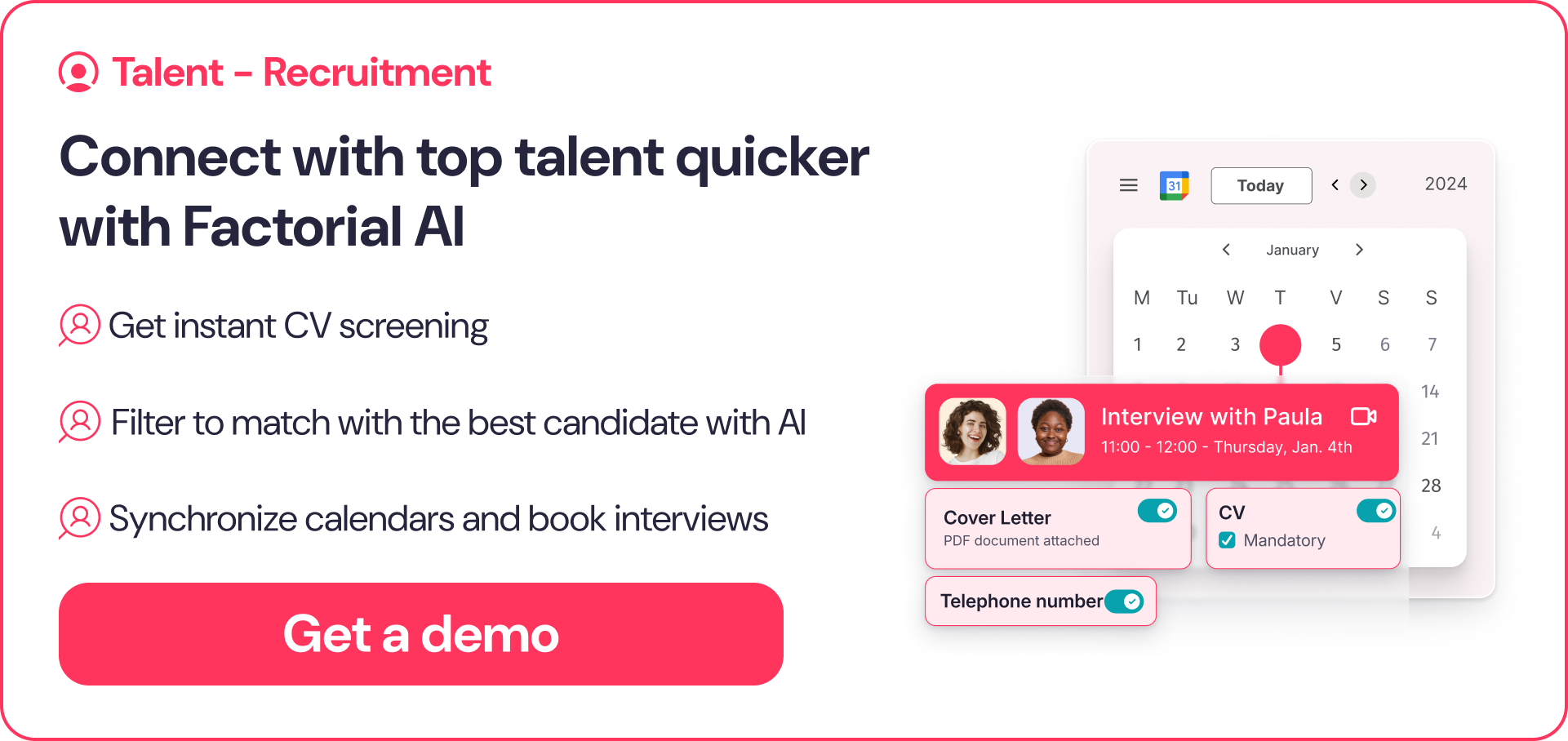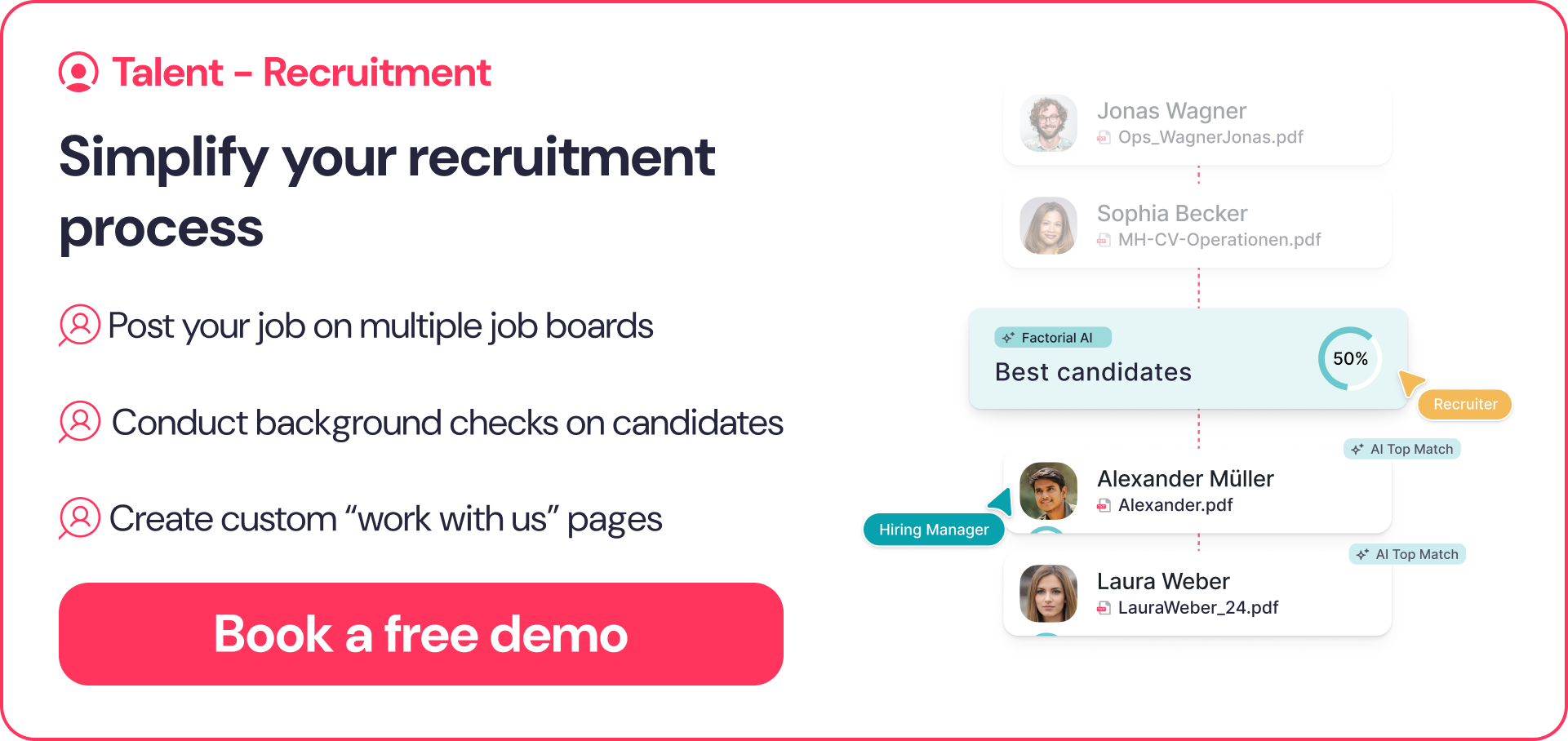Recruiting employees to fill vacant or new positions in an organisation is time-consuming. It pays to think about how you want to run the recruitment process and how to standardise it as much as possible. In this article, we look at the benefits of having a recruitment process policy and provide suggestions for what to include when writing one.
TABLE OF CONTENTS
- What is a Recruitment Process Policy?
- Benefits of a Recruitment Process Policy
- What to include in a Recruitment Process Policy
- How Factorial can help with your Recruitment Process
- See Factorial in Action and book a FREE demo today 🚀
What is a Recruitment Process Policy?
A recruitment process policy clarifies a company’s hiring procedures. It includes the company’s general ethos when recruiting talent and specific information on how roles will be advertised, how applicants will be screened and shortlisted, the interview process, whether feedback will be provided, and the process to be followed if an offer of employment needs to be revoked. This ensures consistency and streamlines the recruitment process for everyone involved.
The process for external and internal candidates may be outlined in the same policy, or two policies can be created. Think about your company’s needs and determine what works best for your team. In some cases, creating separate hiring policies for internal and external candidates can be beneficial, as internal candidates often have a shorter interview process.
Additionally, the recruitment process policy may also be called an employee recruitment, selection policy or simply an employee recruitment policy. As each business will have their preferred name for these policies.
Benefits of a Recruitment Process Policy
Why should SMBs, HR teams, or employers implement a recruitment process policy? Well, there are several benefits for employers from having a recruitment process policy. We’ve outlined 5 of the top benefits:
Ensures Fairness and Legal Compliance
A policy outlining the process for recruiting new employees enables companies to be confident that they are consistent and fair in treating people applying for roles. In addition to promoting diversity and inclusion by reducing the risk of unconscious bias influencing the selection of applicants, having a consistent approach helps organisations comply with anti-discrimination laws such as the Equality Act 2010. Implementing hiring policies in turn ensures your comapny is staying compliant with employment regulations.
Delivers Efficiencies
A transparent process that hiring managers can follow step-by-step reduces time spent on unnecessary tasks and encourages managers to share resources to streamline their tasks. Moreover, having clear structure minimises the chance of miscommunication or misunderstanding between the company and candidates which can be costly and time-consuming to resolve. Ultimately, clear steps and communication is beneficial for both the candidate and employer to assure an efficient recruitment process.
Attracts Better Candidates
A recruitment process policy defines how to advertise roles and what to include in job descriptions, ensuring candidates have the information they need to make informed application decisions. For companies, using a competency-based interview process reduces the risk of hiring candidates who may not be suitable for the specific role. This leads to better employee retention and enhances the company’s external reputation as a fair and honourable recruiter, which in turn leads to positive recommendations.
Reduced Costs
A streamlined recruitment approach can lower costs by making the hiring process more efficient and ensuring the right candidate is selected for the job. This, in turn, reduces expenses related to training, poor performance, and rehiring due to a bad fit. A shorter and more efficient hiring process reduces your HR team’s recruitment costs, freeing up resources for other projects.
Supports Strategic Workforce Planning
Companies with a recruitment process policy are more likely to take a proactive approach to recruitment because the policy helps to clarify how recruitment relates to the bigger picture of business goals and longer-term workforce planning. For example, a company committed to inclusion and diversity will implement a policy that ensures fair treatment of all candidates in the selection process, strengthening workplace diversity and supporting the company’s strategic goals.
What to Include In A Recruitment Process Policy
A recruitment process policy should include the following sections:
General Principles or Overview
At the start, clearly outline your company’s recruitment principles and commitment to fair hiring. Provide an overview of the process, from identifying a vacancy to making an offer. For most companies, general principles will include a commitment to a fair, transparent and standardised process, adherence to employment laws and equal opportunity for all candidates. It can also be helpful to include a sentence explaining how the recruitment process will be made accessible for people with additional needs.
In larger organisations, this section clarifies how the HR department collaborates with other departments during recruitment and whether they will use outside agencies.
Guidelines for Advertising Roles
In this section, the policy must cover writing a job description and the approach to posting the advertisement for the role. Details of how to approach advertising a role internally and externally, which platforms to use and who needs to approve the job posting should be included here. Include templates if they are available for writing job descriptions and signposts to any advice or previous examples that hiring managers may find helpful.
Selection Stages
Include information on how candidates should apply for roles in your company (via email or an online portal or if you use a recruitment agency) and what needs to be included in their application. Also, outline the standard stages for selecting the most suitable candidate: screen CVs, conduct a possible phone call, and hold interviews (including multiple rounds if necessary). Some roles may require a short test, and some organisations may use group work or interviews as part of their recruitment process. Remember to add a sentence clarifying that you may amend the process as required depending on the individual circumstances and the role involved.
Interview Process
Here, the company outlines its approach to interviews, starting with a commitment to ensuring that those conducting the interviews treat the applicant fairly. Confirming that interviewers attend training on bias awareness and agree to use a standard set of questions and criteria to mark against before they start the process is an essential part of this approach. It may also be necessary to spell out if the organisation is committed to using different types of interviews as appropriate for the role, for example, interviews over the phone, using the panel and behavioural or technical interviews.
Decision Making & Feedback
This section needs to clarify who will be involved in the final decision and what criteria need to be considered to do so. To ensure a fair process for all, the criteria used to decide on who gets a role need to be agreed upon ahead of time by key stakeholders. Include guidance on how to give feedback to unsuccessful candidates. If time constraints limit feedback, specify in the policy that candidates must be informed of this during the process.
Offer Process
Clarify what the offer should include (salary, benefits, probation period, working conditions) when made to a successful candidate and the reference checks process. It can be helpful to clarify how an offer is made to an individual applicant sets the tone for the future working relationship. Organisations that use a more personal touch at this stage in the recruitment process demonstrate that they value their employees as individuals.
It can also be helpful to include guidance on approaching the difficult situation of having to revoke an offer.
Commitment to Best Standards
The last section of a recruitment process policy should focus on what will be done to keep the process current and fit for purpose. This can include training for HR staff and hiring managers involved in the process and a commitment to regularly review the policy and ensure it remains compliant with employment laws and upholds a fair, consistent approach. It should also include how the policy will be communicated and made accessible to all potential candidates (internally and externally).
How Factorial Can Help with Your Recruitment
Ready to implement your own recruitment process policy, but need help with the actual recruiting process? Factorial can help with that! With our intuitive applicant tracking system, you can write job descriptions in no time with Factorial AI, customise your screening questions and conduct background screening checks for legal compliance. Our AI-powered tools save time creating job descriptions and filtering candidates, and our system allows you to have an overview of all open positions and where they are in the process at any one point in time. You’ll have all communication from the company and candidate centralized, making it easy to reference any key talking points or documents.
See how Factorial can transform your recruitment process! Book your FREE demo now.



